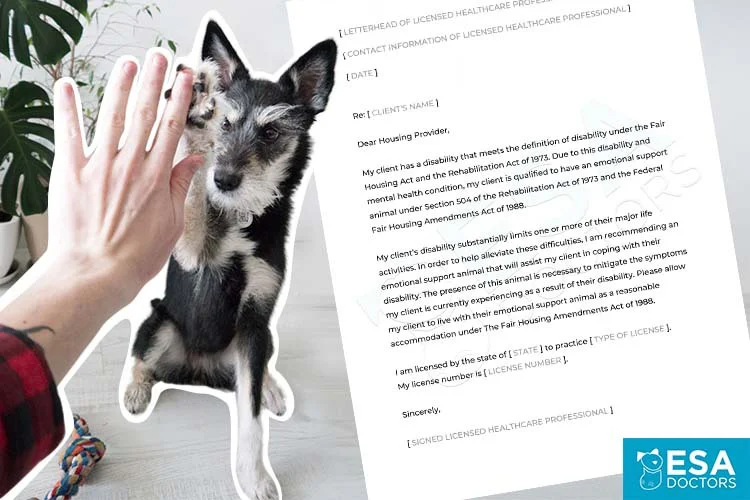Congratulations, your therapist or doctor just approved you for an emotional support animal and gave you a signed ESA letter!
Once you receive your ESA letter, your pet — or future pet — has officially qualified as an emotional support animal. As an ESA owner, you have special rights for housing — including the ability to live in no-pets buildings without any charge and exemption from animal restrictions, like weight and size.
All of this is possible because you now have an ESA letter proving that you are in need of an ESA. But what do you do now? Who is entitled to see it? How do you send it to your landlord? We’ll address those questions in this post.
How to submit your ESA letter to your landlord
If you are using your ESA letter for housing, the process for submitting an ESA letter to a landlord generally looks like this:
- Inform your landlord you are requesting accommodation of an emotional support animal, orally or in writing.
- Give your landlord a copy of your ESA letter.
- Give your landlord time (no more than 10 days) to decide whether they accept your ESA — they can only deny you for a few reasons.
- If your landlord raises any concerns about your emotional support animal, they must engage in an interactive process with you to resolve any issues.
- Once your landlord has given their approval, you can bring your emotional support animal home!
Below are more details for each of these 5 steps:
1. Inform your Landlord
Once you have your ESA letter, you should let your landlord know that you will be requesting accommodation for your ESA. You can inform them orally or in writing, but having things in writing, like with an email, is preferable.
You can submit an ESA request before or after signing your lease. The person you send the request to may be the property owner, a property manager, HOA, condo or co-op board, or another building representative. Keep in mind that your landlord can never charge an application fee for considering your ESA request.
2. Give your landlord a copy of your ESA Letter
The next step is to send your landlord a copy of your ESA letter. Your landlord is entitled to see an ESA letter to verify that you actually have an emotional support animal and not just a normal pet. You can give them a digital copy by email or a hardcopy. You don’t need a “wet ink signature” version; many ESA letters are signed digitally by the healthcare professional, so a version of the letter signed with a pen on paper might not even exist.
People often ask whether you need to send a cover message along with your ESA letter. You can simply inform your landlord that you are requesting accommodation under the Fair Housing guidelines for an emotional support animal and show them your ESA letter. The landlord is not entitled to any other documentation or specifics about your mental health diagnosis or medical history. In the past, landlords made tenants use their forms instead of an ESA letter, but the latest HUD guidelines ended that practice.
You can submit an ESA letter to your landlord before or after signing your lease, and before or after adopting your ESA. However, you should submit the letter before moving your ESA into your home, especially if your building prohibits pets.
3. Give your landlord time to respond
Under HUD guidelines, landlords should respond to your ESA request promptly, no later than 10 days. During this period, they can raise any issues they might have with your ESA accommodation.
Landlords have limited reasons to deny an ESA accommodation. A valid reason includes if they have evidence that your ESA poses a direct threat to the health and safety of other tenants. They cannot deny an ESA solely because the animal is prohibited by building policies.
4. Work through any issues with your landlord
If the landlord does reject your ESA request, they must engage in an interactive dialogue with you to resolve the issue and come to a reasonable compromise. It’s best to have an open conversation with your landlord and try to come to an agreement where both sides are happy.
5. Once you obtain approval, bring your ESA home!
Once your landlord gives you their approval, you can bring your ESA home. Your ESA may be a pet that was already living with you under the landlord’s policies for normal pets — that is a common situation.
As an ESA owner, it’s important to be mindful of other tenants. Especially in buildings that ban pets, you want to ensure that your ESA is a model citizen and not a cause for concern. The majority of ESAs peacefully coexist with other tenants and animals without any problems.
Final Thoughts
Most landlords are happy to comply with their Fair Housing obligations and ESA accommodation requests. However, if you run into any trouble, it’s important to keep a record of when you submitted your ESA letter and any responses from your landlord. Many housing providers have faced charges due to their failure to comply with HUD’s emotional support animal guidelines.
Most ESA owners have a smooth process with their ESA requests. It is a routine procedure for many housing providers. If you have a valid ESA letter, you can be confident that your rights are protected by federal and even some state laws.










Leave a Comment